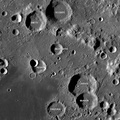
WIKIARCHIVES.SPACE
The Human Spaceflight Archive

Craters in the center of Apollo basin (36°S, 209°E) named after Space Shuttle Challenger astronauts, LROC WAC mosaic, ~190 kilometers wide.
Information
- Taken in
- Author
- NASA/GSFC/Arizona State University
- Description
-
Craters in the center of Apollo basin (36°S, 209°E) named after Space Shuttle Challenger astronauts, LROC WAC mosaic, ~190 kilometers wide.
Apollo is a 524 km-diameter impact basin located within the center of the giant South Pole-Aitken basin. After the loss of the Space Shuttle Challenger, seven craters on the eastern rim of this basin were named after the crew: Gregory Jarvis, Christa McAuliffe, Ronald McNair, Ellison Onizuka, Judith Resnik, Dick Scobee, Michael Smith.
NASA's Goddard Space Flight Center built and manages the mission for the Exploration Systems Mission Directorate at NASA Headquarters in Washington. The Lunar Reconnaissance Orbiter Camera was designed to acquire data for landing site certification and to conduct polar illumination studies and global mapping. Operated by Arizona State University, LROC consists of a pair of narrow-angle cameras (NAC) and a single wide-angle camera (WAC). The mission is expected to return over 70 terabytes of image data.
- Created on
- Saturday 29 January 2011
- Albums
- US SPACE PROGRAM / PROBES / MOON / LRO/LCROSS / Annoted/Science
- Source link
- https://photojournal.jpl.nasa.gov
- Visits
- 18
- Rating score
- no rate
- Rate this photo
- License
- Public Domain
- Modified by WikiArchives
- No (original)
- Downloads
- 0
Powered by Piwigo


